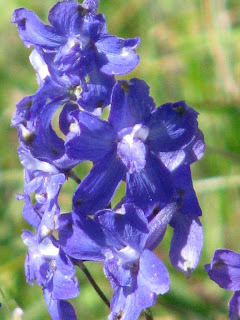Rich saturated glowing blue color in flowers is rare.
On our property here in Calistoga, CA, we are fortunate in having three native larkspur, genus Delphinium, the scarlet Delphinium nudicaule, the dark purple-blue D. decorum, and the cobalt blue to purple-blue D. variegatum. I do not want in any way to disparage the other two for they are exceptional species, but the glistening cobalt blue D. variegatum is hard to get enough of.
This species seems to have more color variation than either of the two other mentioned which are fairly constant. One extreme here is the darker purple type.

 This species grows in clay soils that are wet during the winter months, often with water oozing from the bank edge where these grow here. The other two have their distinct habitats; the scarlet larkspur grows in fractured rock and rubble, while the D. decorum grows on steep slopes in a clay/gravel mix typically at the edge of woodland or under deciduous oaks.
This species grows in clay soils that are wet during the winter months, often with water oozing from the bank edge where these grow here. The other two have their distinct habitats; the scarlet larkspur grows in fractured rock and rubble, while the D. decorum grows on steep slopes in a clay/gravel mix typically at the edge of woodland or under deciduous oaks.
 This is a drift of the larkspur on the edge of a precipice in Calistoga. Over the years I've seen many fabulous displays of this native plant. Perhaps the most memorable was several acres of vernally wet clay meadow called Morgan Valley near the Reif-Rayhouse Rd. in southern Lake Co.
This is a drift of the larkspur on the edge of a precipice in Calistoga. Over the years I've seen many fabulous displays of this native plant. Perhaps the most memorable was several acres of vernally wet clay meadow called Morgan Valley near the Reif-Rayhouse Rd. in southern Lake Co.
As glorious as this larkspur is to enjoy in the wild, it is not considered transferable to a garden setting, though folks will keep trying. The larkspurs in horticulture are generally preferable in this regard, though even those can be a challenge -but one with great reward.
A plant that I grow in my garden here in Calistoga that shows great promise for a stunning blue flowered panicle several feet tall is the rare Echium gentianoides, or tajinaste azul. It is restricted in the wild to the mountains on the island of La Palma in the Canary Island group. Annie Hays of Annie's Annuals has propagated this beauty. I was initially cautious, as other Echium species have become noxious weeds in the coastal regions of California. But I cut up the seed stalks of E. gentianoides last year and have not seen a single seedling yet in my garden, though I'll continue to monitor the situation.

 Two views of the Echium in front of a large Spanish olive oil urn, pictures taken yesterday. It is an unusual Echium as the leaves are not bristly hairy but smooth with a lovely silver-blue color and pinkish petioles and stems. It is very heat and drought tolerant here, though the plants go into a semi-dormant late summer phase, but come back quickly during the winter. According to Warren Roberts, superintendent of the UC Davis Arboretum, it comes from areas that receive snow, thus is hardier than many of the other echium. I do not know, however, what the bottom line is for temperatures, as our Calistoga garden is amazingly mild with no freezes in 3 years.
Two views of the Echium in front of a large Spanish olive oil urn, pictures taken yesterday. It is an unusual Echium as the leaves are not bristly hairy but smooth with a lovely silver-blue color and pinkish petioles and stems. It is very heat and drought tolerant here, though the plants go into a semi-dormant late summer phase, but come back quickly during the winter. According to Warren Roberts, superintendent of the UC Davis Arboretum, it comes from areas that receive snow, thus is hardier than many of the other echium. I do not know, however, what the bottom line is for temperatures, as our Calistoga garden is amazingly mild with no freezes in 3 years.I originally bought 3 plants, two are this rich deep blue while one is paler, but still an excellent color. I believe they are currently all seed grown, so some variability is to be expected - so if you come across it, buy several. Also can be ordered from Annie's website, http://www.anniesannuals.com/.
The botanical species name, gentianoides, refers to the rich blue flower color that is simiar to that commonly found in the genus, Gentiana, or gentian. Gentians are often plants of mountain meadows and are noted for their deep blue flower color, gentian-blue often being used as a color name.




No comments:
Post a Comment